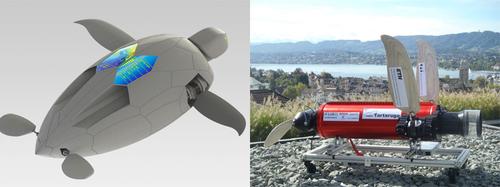Sea Turtle Robot Will Swim Autonomously
October 19, 2012

We've seen a robotic tuna and robots that swim more or less like people. Now engineers at the Swiss Federal Institute of Technology have built a robot modeled on a sea turtle.
The Naro-Tartaruga is the second generation of the Institute's Naro (nautical robot) project. The original Naro was based on a tuna fish, which the project's Website says is one of the fastest swimmers in the world, with speeds of up to 80kph (49.7mph). The tuna's speed was also cited by the Department of Homeland Security's Science & Technology Directorate as the reason for modeling its autonomous underwater unmanned vehicle (UUV), the BIOSwimmer, after a tuna.
The Swiss Institute's engineers developed their robot tuna with the main goal of a proof-of-concept for bio-inspired locomotion, especially robotic propulsion via flapping fins. Made of fiberglass, the first-generation Naro is 1m (3.28 ft) long, weighs 13kg (28.7 lb), and swims at an estimated speed of 1m per second.

But the first Naro does not operate autonomously. For their second generation robot swimmer, the Naro-Tartaruga, the Swiss engineers wanted to implement underwater autonomous navigation in addition to remote control. To do this, the robot will be equipped with a variety of sensors for different tasks. These include sensors for pressure, temperature, water flow, and water leakage, as well as gyros, motor encoders, GPS for surface use, and a compass, presumably for underwater use. Its vision sensors are a BlueFox camera from Matrix Vision and its CPU is an Intel i7 dual-core processor.
The engineers decided to use a sea turtle as their model primarily because of its rigid body, which, according to their Website, "is technically much simpler to realize than a [sic] agile body of a fish. The big torso also provides enough space for sensors and batteries which are essential for autonomy." The robot turtle's body is made of aluminum, which will protect all that equipment a lot better than the first Naro's fiberglass hull.
Like the Naro, the second-generation sea turtle robot is also 1m long, but weighs much more at 75kg (165.3 lb). The Naro-Tartaruga is also twice as fast at an estimated speed of 2m per second. It has a diving depth of 100m (328 ft), compared to the Naro's 5m (16.4 ft).
With the Naro-Tartaruga, the researchers say they will be able to provide the first direct measurements of the energy consumed by a robotic flapping fin mechanism. Most systems for creating mechanical flapping fins for use underwater have depended on serial actuation principles. In these systems, one motor drives a box and a second motor drives the fin. These designs call for several different sealed bodies, connected by cables, and an architecture that increases both energy consumption and the risk of leaks.
In contrast, each of the Naro-Tartaruga's fins is driven by three actuators, which include six 200W brushless and two 15W brushless Maxon Motor devices. All three actuate the fin axle independently, but they're contained in a single waterproof body, reducing the risk of leakage and energy consumption.
This looks like a well-thought-out, smart design: rugged materials, equipped with all the needed sensors, and with actuators that better emulate an animal's elegant and powerful fin movements.
Related posts:
About the Author(s)
You May Also Like



